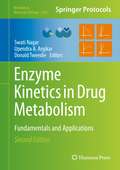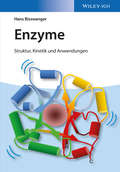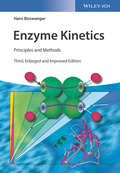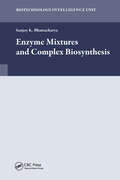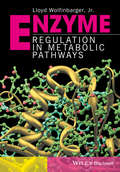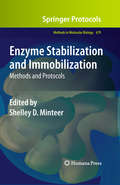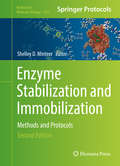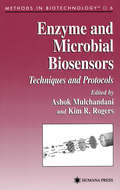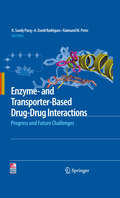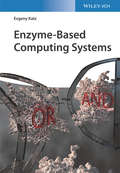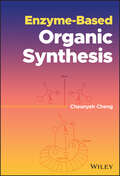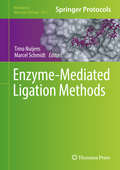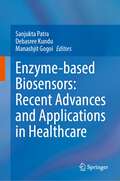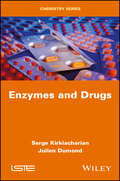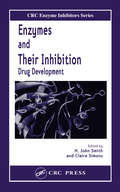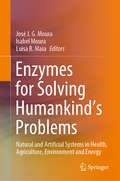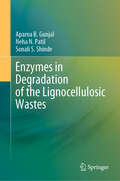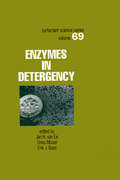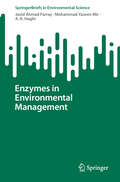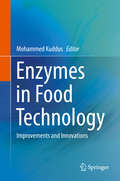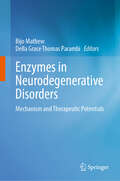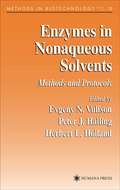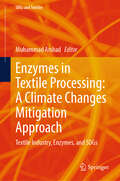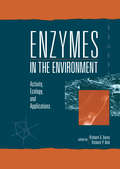- Table View
- List View
Enzyme Kinetics in Drug Metabolism: Fundamentals and Applications (Methods in Molecular Biology #2342)
by Swati Nagar Upendra A. Argikar Donald TweedieThis second edition further develops the principles of applying kinetic principles to drug metabolizing enzymes and transporters. Chapters are divided into six sections detailing fundamental principles of enzyme kinetics, enzyme and transporter structures, highlighting specific oxidative and conjugative drug metabolizing enzymes and drug transporters, modeling approaches for drug metabolizing enzymes and transporters, understanding of variability both experimental and interindividual (pharmacogenomic), and expanded case studies that provide real life examples of applying these principles. Written in the highly successful Methods in Molecular Biology series format, chapters include introductions to their respective topics, in some cases step-by-step instructions with readily reproducible laboratory protocols, and tips on troubleshooting and avoiding known pitfalls with extensive cross referencing to assist in learning. Authoritative and fully updated, Enzyme Kinetics in Drug Metabolism: Fundamentals and Applications, Second Edition serves as a practical teaching tool for novice and advanced scientists interested in the fundamental concepts.
Enzyme Kinetics: Principles and Methods
by Hans BisswangerThis new, expanded and updated edition of the user-friendly and comprehensive treatise on enzyme kinetics expertly balances theory and practice. This is an indispensable aid for advanced students and professionals working with enzymes, whether biochemists, biotechnologists, chemical biologists, pharmacologists or bioengineers in academia, industry and clinical research.
Enzyme Kinetics: Principles and Methods
by Hans BisswangerNow in full color for a more intuitive learning experience, this new edition of the long-selling reference also features a number of new developments in methodology and the application of enzyme kinetics. Starting with a description of ligand binding equilibria, the experienced author goes on to discuss simple and complex enzyme reactions in kinetic terms. Special cases such as membrane-bound and immobilized enzymes are considered, as is the influence of external conditions, such as temperature and pH value. The final part of the book then covers a range of widely used measurement methods and compares their performance and scope of application. With its unique mix of theory and practical advice, this is an invaluable aid for teaching as well as for experimental work.
Enzyme Mixtures and Complex Biosynthesis
by Sanjoy K. BhattacharyaIn this book, an ensemble of examples is provided to illustrate the diversity of approaches and applications to which the multi-enzyme catalysis is currently applied. Enzymes act in living beings as extremely complex, network mixtures that are supportive of all the biochemical transformations on which the life is based. In the biotechnological context, many of the enzymatic processes performed in vitro at both small and industrial scales lie on the enzymatic transformation of a single molecular species for the generation of a product and as catalyzed by a single enzyme. However, the number of technological applications for which cell-free enzyme mixtures are required is increasing and the science of how to combine individual reactions in complex processes is under speedy development. Obviously, any of the current in-progress multi-enzyme processes is fully mimicking the complexity of a living cell or cell community. However, the refined combination of selected enzymes and substrates is offering a new technological approach that is supporting the development of new or improved products in many fields such as food, leather and pharmaceutical industries. This book is unique and presents selective examples of each of these processes have been incorporated in this book by experts in their respective areas.
Enzyme Regulation in Metabolic Pathways
by Lloyd Wolfinbarger Jr.Enzyme Regulation in Intermediary Metabolism shows the reader how to understand the roles of enzymes and their kinetic constants in intermediary metabolism. It provides a means of correlating data obtained in experimental studies to multiple possible mechanisms through which some enzyme may catalyze the conversion of a substrate to a product. Although not the most appropriate means of determining some potential kinetic mechanism, quasi-equilibrium assumptions are used throughout the book, keeping the rate equation derivations simple. Actual metabolic pathways with known (presumed) positive and negative regulation events are linked to these potential kinetic mechanisms using both rate equation derivations and data plots illustrating how the rate equation derivations can be used to explain the data plots. This book will be a valuable reference for students in biological sciences and biochemistry majors required to take a core course in enzymology.
Enzyme Stabilization and Immobilization
by Shelley D. MinteerIn the past decade, researchers have made tremendous progress in the field of enzyme stabilization, opening up new opportunities for enzymes in molecular biology and for industrial applications. In Enzyme Stabilization and Immobilization: Methods and Protocols, expert researchers explore the latest developments through detailed laboratory protocols, which address many different theories and techniques in enzyme stabilization. Chapters outline protocols for enzyme stabilization in solutions, including: liposome formation, micelle introduction, crosslinking, and additives. Secondly, the book contain protocols for enzyme stabilization via enzyme immobilization, such as sol-gel encapsulation, polymer encapsulation, and single enzyme nanoparticle formation. Composed in the highly successful Methods in Molecular BiologyTM series format, each chapter contains a brief introduction, step-by-step methods, a list of necessary materials, and a Notes section which shares tips on troubleshooting and avoiding known pitfalls. Comprehensive and current, Enzyme Stabilization and Immobilization: Methods and Protocols is an essential handbook for all molecular biologists, biochemists, and biomedical and biochemical engineers.
Enzyme Stabilization and Immobilization
by Shelley D. MinteerThis volume introduces the reader to the field of enzyme stabilization and the different theories of enzyme stabilization, including the use of immobilization as a stabilization technique. The first part of the book focuses on protocols for enzyme stabilization in solutions including liposome formation, micelle introduction, crosslinking, and additives. The second part of the book discusses protocols for enzyme stabilization during enzyme immobilization, including common techniques like sol-gel encapsulation, polymer encapsulation, and single enzyme nanoparticle formation. Protocols for a variety of enzymes are shown, but the enzymes are chosen as examples to show that these protocols can be used for both enzymes of biological importance, as well as enzymes of industrial importance. The final part details spectroscopic protocols, methods, and assays for studying the effectiveness of the enzyme stabilization and immobilization strategies. Written in the highly successful Methods in Molecular Biology series format, chapters include introductions to their respective topics, lists of the necessary materials and reagents, step-by-step, readily reproducible laboratory protocols, and tips on troubleshooting and avoiding known pitfalls. Cutting-edge and thorough, Enzyme Stabilization and Immobilization: Methods and Protocols, Second Edition provides molecular biologists, biochemists, and biomedical and biochemical engineers with the state-of-the-art technical information required to effectively stabilize their enzyme of interest in a variety of environments (i. e. , harsh temperature, pH, or solvent conditions).
Enzyme and Microbial Biosensors
by Kim Rogers Ashok MulchandaniA cutting-edge collection of detailed, step-by-step techniques and protocols for constructing, evaluating, and using enzyme- and microbial-based biosensors. Ideal for novices starting research in their field or experienced researchers wanting to use a biosensor for a specific analytical measurement, the methods detailed here allow biochemists, analytical chemists, microbiologists, and engineers to successfully apply biosensor technology to their specific problems. The techniques include classical enzyme biosensors based on potentiometric, amperometric, conductimetric, optical, and thermal transducers, as well cell-based biosensors based on amperometric and optical transducers. A companion volume, Affinity Biosensors: Protocols and Techniques, by Rogers & Mulchandani, concentrates on cell- and affinity-based biosensors.
Enzyme- and Transporter-Based Drug-Drug Interactions
by A. David Rodrigues Raimund M. Peter K. Sandy PangGermination of the thought of "Enzymatic- and Transporter-Based Drug-Drug Interactions: Progress and Future Challenges" Proceedings came about as part of the annual meeting of The American Association of Pharmaceutical Scientists (AAPS) that was held in San Diego in November of 2007. The attendance of workshop by more than 250 pharmaceutical scientists reflected the increased interest in the area of drug-drug interactions (DDIs), the greater focus of PhRMA, academia, and regulatory agencies, and the rapid pace of growth in knowledge. One of the aims of the workshop was to address the progress made in quantitatively predicting enzyme- and transporter-based DDIs as well as highlighted areas where such predictions are poor or areas that remain challenging for the future. Because of the serious clinical implications, initiatives have arisen from the FDA (http://www.fda.gov/cber/gdlns/interactstud.htm) to highlight the importance of enzyme- and transporter-based DDIs. During the past ten to fifteen years, we have come to realize that transporters, in addition to enzymes, play a vital role in drug elimination. Such insight has been possible because of the continued growth in PK-ADME (pharmacokinetics-absorption-distribution-metabolism-excretion) knowledge, fueled by further advances in molecular biology, greater availability of human tissues, and the development of additional and sophisticated model systems and sensitive assay methods for studying drug metabolism and transport in vitro and in vivo. This has sparked an in-depth probing into mechanisms surrounding DDIs, resulting from ligand-induced changes in nuclear receptors, as well as alterations in transporter and enzyme expression and function. Despite such advances, the in vitro and in vivo study of drug interactions and the integration of various data sets remain challenging. Therefore, it has become apparent that a proceeding that serves to encapsulate current strategies, approaches, methods and applications is necessary. As Editors, we have assembled a number of opinion leaders and asked them to contribute chapters surrounding these issues. Many of these are the original Workshop speakers whereas others had been selected specially to contribute on topics related to basic and applied information that had not been covered in other reference texts on DDI. The resulting tome, entitled Enzyme- and Transporter-Based Drug Interactions: Progress and Future Challenges, comprises of four sections. Twenty-eight chapters covering various topics and perspectives related to the subject of metabolic and transporter-based drug-drug interactions are presented.
Enzyme-Based Computing Systems
by Evgeny KatzThis systematic and comprehensive overview of enzyme-based biocomputing is an excellent resource for scientists and engineers working on the design, study and applications of enzyme-logic systems.
Enzyme-Based Organic Synthesis
by Cheanyeh ChengEnzyme-Based Organic Synthesis An insightful exploration of an increasingly popular technique in organic chemistry In Enzyme-Based Organic Synthesis, expert chemist Dr. Cheanyeh Cheng delivers a comprehensive discussion of the principles, methods, and applications of enzymatic and microbial processes for organic synthesis. The book thoroughly explores this growing area of green synthetic organic chemistry, both in the context of academic research and industrial practice. The distinguished author provides a single point of access for enzymatic methods applicable to organic synthesis and focuses on enzyme catalyzed organic synthesis with six different classes of enzyme. This book serves as a link between enzymology and biocatalysis and serves as an invaluable reference for the growing number of organic chemists using biocatalysis. Enzyme-Based Organic Synthesis provides readers with multiple examples of practical applications of the main enzyme classes relevant to the pharmaceutical, medical, food, cosmetics, fragrance, and health care industries. Readers will also find: A thorough introduction to foundational topics, including the discovery and nature of enzymes, enzyme structure, catalytic function, molecular recognition, enzyme specificity, and enzyme classes Practical discussions of organic synthesis with oxidoreductases, including oxidation reactions and reduction reactions Comprehensive explorations of organic synthesis with transferases, including transamination with aminotransferases and phosphorylation with kinases In-depth examinations of organic synthesis with hydrolases, including the hydrolysis of the ester bond Perfect for organic synthetic chemists, chemical and biochemical engineers, biotechnologists, process chemists, and enzymologists, Enzyme-Based Organic Synthesis is also an indispensable resource for practitioners in the pharmaceutical, food, cosmetics, and fragrance industries that regularly apply this type of synthesis.
Enzyme-Mediated Ligation Methods (Methods in Molecular Biology #2012)
by Timo Nuijens Marcel SchmidtThis volume discusses different enzyme-catalyzed ligation methodologies for a variety of different chemical transformations. This book wants readers to view enzymes as a powerful tool in both academic and industrial research. Chapters in this book cover topics such as sortase A-mediated generation of site-specifically conjugated antibody-drug conjugates; omniligase-catalyzed inter- and intramolecular ligation; ligation catalyzed by microbial transglutaminase; peptide cyclization mediated by cyanobactin macrocyclases, butelase 1 and sortase A; using BioID as a tool for protein proximity labeling in living cells; and inducible, selective labeling of proteins via enzymatic oxidation of tyrosine. Written in the highly successful Methods in Molecular Biology series format, chapters include introductions to their respective topics, lists of the necessary materials and reagents, step-by-step, readily reproducible laboratory protocols, and tips on troubleshooting and avoiding known pitfalls.Cutting-edge and thorough, Enzyme-Mediated Ligation Methods is a valuable resource for students and scientists from different disciplines who are interested in using enzymatic strategies to answer their research questions.
Enzyme-based Biosensors: Recent Advances and Applications in Healthcare
by Manashjit Gogoi Sanjukta Patra Debasree KunduThis book summarizes the principles, protocols, and applications of enzyme-based biosensors in healthcare. After providing a brief history and discussing the development of various biosensors used for medical applications, it explores the principles of enzyme-based biosensors and reviews a number of enzyme immobilization techniques. It then addresses the potential of enzyme-based biosensors in the diagnosis of infectious and non-infectious diseases; illustrates the potential of enzyme-based biosensors for non-invasive monitoring of biochemical biomarkers; and assesses the application of paper-based and microfluidic-based nanobiosensors in medical diagnostics. A one-stop resource on recent advances in enzyme-based biosensors in healthcare, this book will appeal to students, researchers and scientists in a range of disciplines, as well as entrepreneurs, and medical/healthcare professionals.
Enzymes and Drugs
by Serge Kirkiacharian Julien DumondEnzyme dysfunction, an essential catalyst for the smooth running of biochemical reactions and the maintenance of vital processes, is at the root of many pathologies that have paved the way for the development of numerous drugs. Aimed at pharmacists, biologists, biochemists, doctors, veterinarians, medicinal chemists and students from a wide range of disciplines, Enzymes and Drugs brings together, for the first time, extensive documentation highlighting the relationships between a large number of drugs and enzymes. The book also highlights new prospects for therapeutic discoveries offered by enzyme targeting. Numerous applications have been developed thanks to strategies for studying enzyme inhibition or activation, as well as the development of allosteric effectors, presented with their advantages and disadvantages. Various rare diseases, known as "orphan" diseases, have resulted from enzyme deficiency or absence. For their treatment, the introduction of substitute enzymes has led to major therapeutic advances.
Enzymes and Their Inhibitors: Drug Development
by H. John Smith Claire SimonsFocusing on the development of enzyme inhibitors as therapeutic drugs, Enzymes and Their Inhibitors: Drug Development provides a concise overview of the chemistry of major types of enzymes and their inhibitors. The opening chapters introduce readers to the structure, functions, mechanisms, and kinetics of enzymes, including their use as disease mar
Enzymes for Pollutant Degradation (Microorganisms for Sustainability #30)
by Sikandar I. Mulla R. N. BharagavaThis book is about different Enzymes from various sources that play an important role in the degradation of an array of pollutants with simultaneous generation of value-added products.This is an “Edited Book” which deals a comprehensive knowledge on the role of different microorganisms/their enzymes in the degradation of pollutants, wastewater treatment with simultaneous production of value added products. It also deals the current state, perspectives and various challenges associated with the microbial/enzymatic degradation of environmental pollutants.This book will provide a profound knowledge on the importance of microorganisms/their enzymes in the degradation of pollutants like pesticides, antibiotics, toxic/hazardous chemicals, endocrine disrupting chemicals/compounds with production of value-added products like bioplastics for the sustainable development of society. It covers various existing wastewater treatment approaches using microorganisms alone and /or in combination of other methods with their merits, demerits and future prospects.
Enzymes for Solving Humankind's Problems: Natural and Artificial Systems in Health, Agriculture, Environment and Energy
by José J. G. Moura Isabel Moura Luisa B. MaiaThis book presents specific key natural and artificial systems that are promising biocatalysts in the areas of health, agriculture, environment and energy. It provides a comprehensive account of the state of the art of these systems and outlines the significant progress made in the last decade using these systems to develop innovative, sustainable and environmentally friendly solutions. Chapters from expert contributors explore how natural enzymes and artificial systems tackle specific targets such as: climate change, carbon footprint and economy and carbon dioxide utilisation; nitrogen footprint and fixation and nitrous oxide mitigation; hydrogen production, fuel cells and energy from bacteria; biomass transformation and production of added-value compounds, as well as biosensors development. This book provides an important and inspiring account for the designing of new natural and artificial systems with enhanced properties, and it appeals not only to students and researchers working in the fields of energy, health, food and environment, but also to a wider audience of educated readers that are interested in these up-to-date and exciting subjects.Chapter “Carbon Dioxide Utilisation—The Formate Route” is available open access under a Creative Commons Attribution 4.0 International License via link.springer.com.
Enzymes in Degradation of the Lignocellulosic Wastes
by Aparna B. Gunjal Neha N. Patil Sonali S. ShindeThis book offers valuable insights into the principles, mechanisms of action and applications of traditional and novel enzymes involved in the degradation of wastes. Enzymes are biological catalysts that play an important role in various biochemical reactions. The generation of value-added products by means of these biological processes is also discussed. This book covers the use of in silico and computational methods in understanding the biodegradation processes, and reveals the importance of enzymes in various biochemical reactions and kinetics. The book’s target audience includes undergraduate and graduate students, faculty members at colleges and universities, research students, scientists and industry professionals.
Enzymes in Detergency (Surfactant Science)
by Jan H. van Ee Onno Misset Erik J. BaasOffers an integrated overview of enzyme use in household detergents, from product development and manufacturing to safety and health-related issues. The text details the major types of enzymes, structure-function relationships, life cycle analyses, protein-engineering techniques, cleaning mechanisms, and past, present and future applications.
Enzymes in Environmental Management (SpringerBriefs in Environmental Science)
by Javid Ahmad Parray Mohammad Yaseen Mir A. K. HaghiEnzymes can help break down plastic waste and make it less harmful to the environment. They can also be used to treat various types of waste, including agricultural and food waste, and wastewater. Enzyme engineering is an important part of chemical biotechnology and helps to keep the environment clean. Making clean and renewable fuels is a priority, and many strategies are being developed to achieve this goal. However, food waste is still a major problem that can harm the environment because most disposal methods are not eco-friendly. This volume aims to inform readers about the latest developments in the use of enzymes for environmental management. This comprehensive resource provides a detailed overview of how enzymes can be used in various sectors to promote ecological sustainability. It covers the composition, properties, characterization, chemistry, and applications of different enzymes in emerging and eco-friendly approaches to waste treatment. It also highlights the latest advancements in sustainable technology and biotechnology enzymes. The book is divided into sections that feature various enzymes used for treating resistant pollutants in wastewater, enzymatically degrading synthetic plastics, and engineering enzymes to impact environmental sustainability positively. It also covers enzymes used in the valorization of waste, enzyme technology in biofuel production, and the recovery of enzymes from food waste. Each chapter presents the enzymes' chemical, physical, and biological attributes and reviews the recent research conducted in this emerging field. The authors hope this document will inspire scientists to explore novel chemical, material, and energy sources in the future and to continue developing innovative applications for enzymes in environmental management.
Enzymes in Food Technology: Improvements and Innovations
by Mohammed KuddusThe integration of enzymes in food processing is well known, and dedicated research is continually being pursued to address the global food crisis. This book provides a broad, up-to-date overview of the enzymes used in food technology. It discusses microbial, plant and animal enzymes in the context of their applications in the food sector; process of immobilization; thermal and operational stability; increased product specificity and specific activity; enzyme engineering; implementation of high-throughput techniques; screening of relatively unexplored environments; and development of more efficient enzymes. Offering a comprehensive reference resource on the most progressive field of food technology, this book is of interest to professionals, scientists and academics in the food and biotech industries.
Enzymes in Neurodegenerative Disorders: Mechanism and Therapeutic Potentials
by Bijo Mathew Della Grace Thomas ParambiThis book delves into the correlation between different enzymes and neurodegenerative disorders. It investigates the intricate processes that contribute to the decline of cognitive functions, memory impairment, and other incapacitating symptoms of Alzheimer's disease. The book examines the roles of diverse enzymes in Amyotrophic Lateral Sclerosis and their effects on the motor neurons, leading to muscle weakness, paralysis, and eventual fatality. Moreover, it examines the association between depression and the enzymes responsible, providing a fresh viewpoint on the biochemical foundation of this ailment. Lastly, the book explores the connection between enzymes and Parkinson's disease, discussing the mechanisms that cause the death of dopamine-producing neurons and the related symptoms. By examining the functions of various enzymes in Parkinson's disease, the book presents a distinct outlook on the intricate interplay between enzymes and several neurological conditions, imparting readers with a comprehensive understanding of the fundamental mechanisms that underlie these disorders.
Enzymes in Nonaqueous Solvents
by Evgeny N. VulfsonIn Enzymes in Nonaqueous Solvents: Methods and Protocols, leading chemists, biochemists, biotechnologists, and process engineers summarize for the first time a wide range of methods for executing enzymatic transformations under nonaqueous conditions. Each method includes detailed step-by-step instructions for its successful completion, a list of materials, and ancillary notes that explain the scientific basis of the procedure, as well as troubleshooting. Also provided are a generic description of key reactions, advice on biocatalyst preparation, discussion of reaction conditions, and instructions on bioreactor design. Comprehensive and state-of-the-art, Enzymes in Nonaqueous Solvents: Methods and Protocols offers today's synthetic chemists, biochemists, and process engineers all the essential information needed to carry out enzymatic reactions in nonaqueous media, as well as to successfully scale up to production quantities.
Enzymes in Textile Processing: Textile Industry, Enzymes, and SDGs (SDGs and Textiles)
by Muhammad ArshadThe book offers a comprehensive overview of low-capital cost technologies for enzyme manufacture and utilization in the textile industry with sustainable bioenergy from effluent. Enzymes produced from renewable sources to replace potentially harmful chemicals in textile products have been outlined in making the textile industry greener and eco-friendly. The current book also addresses the strategies to achieve sustainable development goals (SDGs) and sustainability education in the textile sector. In particular, the use of green enzymes to convert by-products from textile effluents into bioenergy has been highlighted. This book outfits academic researchers, industrial practitioners, and policymakers for the engagement of green enzymes as a step toward sustainable development goals in the textile industry.
Enzymes in the Environment: Activity, Ecology, and Applications (Books In Soils, Plants, And The Environment Ser. #Vol. 86)
by Richard G. Burns Richard P. DickThe need to understand the biological processes that are important for essential aquatic and terrestrial ecosystem function has prompted much research into the field of ecological enzymology. This book presents the two broad areas of application in a compilation of reviews by 21 international experts in their respective fields. The first explores e
